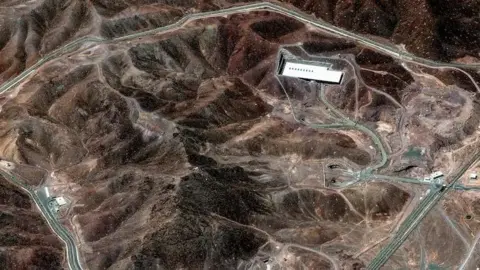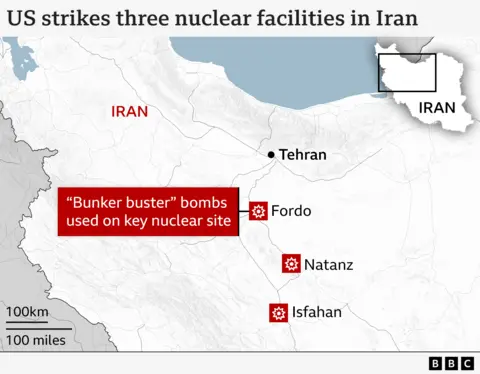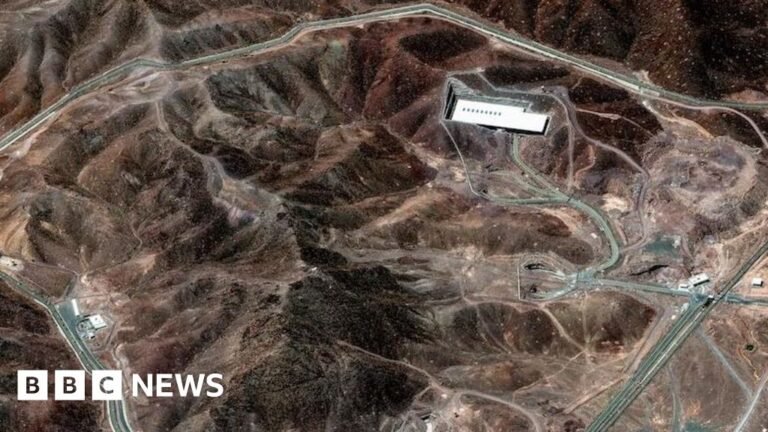BBC News
 Reuters
ReutersPresident Donald Trump says the US has carried out a “successful” bombing attack on three nuclear sites in Iran and said they have been “obliterated”.
Israel says they were in “full co-ordination” with the US in planning the strikes. Iranian officials have confirmed the facilities were struck but denied it had suffered a major blow.
The strikes mark a significant escalation in the ongoing war between Iran and Israel.
Here’s what we know.
What has the US bombed, and what weapons did it use?
One of the targets was Fordo – a uranium enrichment plant hidden in a remote mountainside that is vital to Iran’s nuclear ambitions. We do not yet know the full extent of the damage at the facility.
The US says it also hit two other nuclear sites – at Natanz and Isfahan.

Hidden away in a mountainside south of Tehran, Fordo is believed to be deeper underground than the Channel Tunnel connecting the UK and France.
Due to Fordo’s depth below ground only the US has the kind of “bunker buster” bomb big enough to penetrate the site – the GBU-57 Massive Ordnance Penetrator (MOP).
It weighs 13,000kg (30,000lb) and is able to drop through about 18m (60ft) of concrete or 61m (200ft) of earth before exploding, according to experts.
Due to the depths of Fordo’s tunnels, the MOP is not guaranteed to be successful, but it is the only bomb that could come close.
US media reports say MOPs were used in the strikes.

What is known about the impact of the attacks?
It is unclear yet what damage the US attack has had on the nuclear facilities, or whether there are any injuries or casualties.
The Iranian Atomic Energy Organization said the bombing of the three nuclear sites was a “barbaric violation” of international law.
Both Saudi Arabia and the UN’s nuclear watchdog the International Atomic Energy Agency (IAEA) say there has been no increase in radiation levels after the attack.
The deputy political director of Iran’s state broadcaster, Hassan Abedini, said Iran had evacuated these three nuclear sites a “while ago”. Appearing on state-run TV, he said Iran “didn’t suffer a major blow because the materials had already been taken out”.
How might Iran retaliate?
Iran’s foreign minister condemned the US strike and said Tehran reserved the right to respond. Abbas Araqchi said Trump had “betrayed” Americans who had been promised an end to US involvement in Middle East wars.
Araqchi told a news conference: “It is an outrageous, grave and unprecedented violation of the fundamental principles of the Charter of the United Nations and international law.”
BBC security correspondent Frank Gardner says Iran must now choose between three strategic courses of action in response to the US attack overnight:
- Do nothing. This could spare it from further US attacks. It could even choose the diplomatic route and re-join negotiations with the US. But doing nothing makes the Iranian regime look weak, especially after all its warnings of dire repercussions if the US did attack. It may decide the risk of weakening its grip on its population outweighs the cost of further US attacks
- Retaliate hard and fast. Iran still has a substantial arsenal of ballistic missiles after manufacturing and hiding these away for years. It has a target list of around 20 US bases to choose from in the broader Middle East. It could also launch “swarm attacks” on US Navy warships using drones and fast torpedo boats
- Retaliate later at a time of its own choosing. This would mean waiting until the current tension has subsided and launching a surprise attack when US bases were no longer on maximum alert
Within the hours of the US bombing, Iran launched a fresh wave of missiles towards Israel. Several parts of Tel Aviv as well as the northern city of Haifa were hit – Israeli officials say at least 16 people have been injured.
What did Donald Trump say and how have US politicians reacted?
Posting on his Truth Social platform at 19:50 local time (00:50 BST), Trump confirmed the strikes on Fordo, Natanz, and Esfahan.
Just over two hours later and flanked by Vice President JD Vance, Defence Secretary Pete Hegseth and Secretary of State Marco Rubio, Trump made a televised address.
He said that future attacks would be “far greater” unless Iran reached a diplomatic solution.
“Remember, there are many targets left,” he said.
Several members of Trump’s Republican Party have posted statements in support of the move including Texas Senator Ted Cruz who “commended” the president.
Not every Republican was as supportive with leading Trump backer Congresswoman Marjorie Taylor Greene saying “this is not our fight”.
Leading US Democrat Hakeem Jeffries said Trump risked US “entanglement in a potentially disastrous war in the Middle East”, while others have accused him of bypassing Congress to launch a new war.
Independent Senator Bernie Sanders described the US strikes as “grossly unconstitutional” as the president does not have the sole power to formally declare war on another country. Only Congress – lawmakers elected in the House of Representatives and the Senate – can.
But the law also states that the president is the commander in chief of the armed forces. That means he can deploy US troops and conduct military operations without a formal declaration of war.
How have world leaders reacted?
UK Prime Minister Sir Keir Starmer said the US took action to “alleviate” what he called the “grave threat” posed by Iran’s nuclear programme. In a statement, he called on Tehran to agree to talks and reach a diplomatic solution.
UN secretary general Antonio Guterres said the US air strikes were a dangerous escalation; while European Union foreign policy chief Kaja Kallas urged all sides to step back and return to the negotiating table.
Saudi Arabia has voiced “great concern” while Oman condemned the strikes and called for de-escalation.
Indian Prime Minister Narendra Modi said he had spoken to Iranian President Masoud Pezeshkian and called for “dialogue and diplomacy as the way forward”.
How did this start?
Israel launched a surprise attack on dozens of Iranian nuclear and military targets on 13 June. It said its ambition was to dismantle its nuclear programme, which Prime Minister Benjamin Netanyahu said would soon be able to produce a nuclear bomb.
Iran insists its nuclear ambitions are peaceful. In retaliation, Tehran launched hundreds of rockets and drones at Israel. The two countries have continued exchanging strikes since, in an air war which has now lasted more than a week.
Trump has long said that he is opposed to Iran possessing a nuclear weapon. Israel is widely believed to have them, although it neither confirms nor denies this.
In March, US national intelligence director Tulsi Gabbard said that while Iran had increased its uranium stockpile to unprecedented levels, it was not building a nuclear weapon – an assessment that Trump recently said was “wrong”.
On the campaign trail, Trump had criticised past US administrations for engaging in “stupid endless wars” in the Middle East, and he vowed to keep America out of foreign conflicts.
The US and Iran were in nuclear talks at the time of Israel’s surprise attack. Only two days ago, Trump said he would give Iran two weeks to enter into substantial negotiations before striking – but that timeline turned out to be much shorter.


